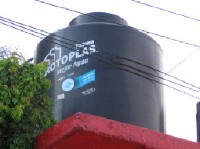Traditionally, the water pressure in your Mexican home would be supplied by a tank of water up on the roof of your home that is called a tinaco in Spanish. Water draining from the tank flows under the force of gravity to the various water fixtures inside the home. This traditionally open water system provides a constant supply of water as long as there is water in the tinaco. For some clients of mine, the flow rate provided by the tinaco system is too slow and they are opting to install water pressure systems in their home to improve the water flow (i.e. number of litres/minute) at the various fixtures in their home. Water pressure systems are also installed as part of a water purification system, however we will not discuss water purification systems in this article.
First, let us understand the reason for a water pressure system. Some homeowners are looking for water flow to improve so that the clothes washer and dishwasher fill quickly, lawn sprinklers spray over a wide area and the showers provide a massage effect as the streams of water bounce off their back and head. The pressure system increases the net pressure in the water distribution system so that the flow in the water pipe increases to provide sufficient flow at the faucets, showerheads, washers, etc.
Another way to improve the water flow out of a tinaco system is by raising the elevation of the tank, hence providing more potential energy in the system of pipes leading out of the tinaco. That is, the higher the tank, the higher the water pressure and the higher the water flow at the faucet or fixture.

A third way to improve the flow is to increase the diameter of the pipes used in the system. Typically water distribution in the house is based on ½ inch diameter pipes however; if the piping was increased to ¾ inch there would more than double the potential flow rate!
Of course, for many homes, installing new ¾ inch pipes is not an option due to cost and inconvenience during the demolition and reinstallation. However, there are cases when remodeling of an existing home, or building a new home in which larger diameter pipes could be considered.
One advantage of a roof tank is that, in most cases, the tanks can be filled by the water pressure available from the street. This is potential energy to fill the tinacos is readily available in most neighborhoods and villages. This removes the necessity of have a pumping system to move water from an underground water cistern (aljibe) to the roof tank and hence the electrical energy required to move the water to the higher elevation. This conservation of electrical energy will reflect on your bimonthly bill since electric pumps (including water pressure systems) are on average one of the larger consumers of electricity on any given property.

The final question is to ask is when do we need the water pressure system to come on? For most homeowners, the most important time is during their showers, unless you’re the one doing the laundry and you do not like waiting for the washer to fill up. So the lower priority items, like the filling of the toilet tank, washing the dishes, and even watering the garden, would not need higher water pressure (higher flow rate).
Recently I met a client, who used an innovative and “green” solution to address this problem. During the time he wanted the higher pressure for a shower, the client turned on his water pressure system, to pump directly from the aljibe to the water distribution system. The water tank on the roof had a check valve mounted on the tank exit to prevent the pressurized water from overfilling the roof tank. When done with his shower, he would shut off the water pressure pump. Hence, most of the day, the house was functioning with only the water pressure provided by the roof tank and it was more than sufficient for the house to function. He hardly ever used the same pressure pump to fill the tinaco, since the water pressure from the street was sufficient to do the job.
As for his garden, he timed the watering of the garden to when the street pressure was turned on, which was sufficient for his watering, spraying and irrigation needs. As a result, this homeowner’s electrical bill was well below average considering the size of the house, because of his conservation of water pressure pump use.




This article mentions time when street water pressure is on. Is it not constant? Is there a way I can increase the water presure in the shower only? I am in a rental, so I would not want to pay for redoing the entire system in the house. I don’t see why it should be so complicated. I am from the US, grew up in a mobile home. There was never a water pressure problem. However, some of my friends who lived in older homes in town did seem to have problems with water pressure. What’s the simplest explanation?
The tinaco is not just for water pressure but to have a constant supply of water. In some places the city water is not too consistent. Off and on a lot.